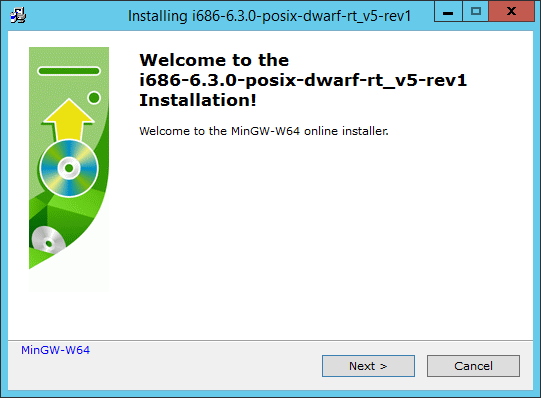
- HOW TO USE MINGW W64 INSTALL
- HOW TO USE MINGW W64 64 BIT
- HOW TO USE MINGW W64 SOFTWARE
Some more details on step 2 can be found in a reference from Microsoft that a previous poster mentioned. In the Properties menu of your project, under Configuration Properties | General, change Platform Toolset from "v100" to "Windows7.1SDK". Now change the "Active solution platform" drop-down menu to "圆4." When you return to the Properties dialog box, the "Platform" drop-down should now read "圆4." In the dialog that comes up, find your project, hit the Platform drop-down, select New, then select 圆4. The development of the MinGW project has been forked with the creation in 20052008 of an alternative project called Mingw-w64.
HOW TO USE MINGW W64 SOFTWARE
Make sure that selects "All Configurations." There will also be a "Platform" drop-down that will read "Win32." Finally on the right there is a "Configuration Manager" button - press it. MinGW ('Minimalist GNU for Windows'), formerly mingw32, is a free and open source software development environment to create Microsoft Windows applications. On the top of the dialog box there will be a "Configuration" drop-down menu.
HOW TO USE MINGW W64 64 BIT
Visual C++ 2010 Express does not include a 64 bit compiler, but the SDK does.
HOW TO USE MINGW W64 INSTALL
Download and install the Windows Software Development Kit version 7.1. It is 90% some directory whose trailing path component is include. (If using python msi installer PYTHONINC is %PYTHON%\include. Why did you try to do that If you want MSYS2s MinGW-w64 x8664 GCC then you should install the mingw-w64-x8664-toolchain package group via: pacman -S mingw-w64-x8664-toolchain. If this does not work try moving them to the make command line: make -f Make_ming.mak CC=x86_64-w64-mingw32-gcc LD=… …Īnd variables for python (should also be present on the command-line): PYTHON="P:\ath\to\directory\with\python" PYTHONINC="P:\ath\to\directory\with\python\header\files" PYTHON_VER=27 PYTHON_VER_LONG=2.7.5 
Click Yes when Windows asks if you want to allow it. Not sure about escaping though.Įxporting environment variables should be probably done with set var=value Installing MinGW Download the MinGW Installer: Select Save File when prompted. VIMRUNTIMEDIR should point to the place where you plan to install vim. You definitely do not need CROSS_COMPILE and CROSS options and ARCH should be probably omitted (or equal to x86_64). Make -f Make_ming.mak FEATURES=HUGE CROSS_COMPILE=i686-pc-mingw32- OPTIMIZE=SPEED VIMRUNTIMEDIR="C:\vim73\runtime" CROSS=yes ARCH=i686

I am not sure why I did this.įinally run make: cd /src
 Export environment variable vim_cv_toupper_broken set to yes. Export environment variable prefix pointing to the directory where mingw resides (in my case it was /usr/i686-mingw32: I am cross-compiling).
Export environment variable vim_cv_toupper_broken set to yes. Export environment variable prefix pointing to the directory where mingw resides (in my case it was /usr/i686-mingw32: I am cross-compiling). 
Be sure they are found on $PATH: I am not sure what kind of escaping you should do to make makefile work so just avoid the necessity for escaping.
Export environment variable LD set to the appropriate linker (in my case it was similar, but with -ld suffix in place of -gcc). Export environment variable CC set to the appropriate compiler (in my case it was 32-bit named i686-pc-mingw32-gcc). To compile vim with MinGW with specific compiler and Make_ming.mak makefile I used to use the following: >Ĭompile::nogen: A library could not be generated from the compiled function.It does not matter from which source make program comes, it only just must be able to execute the Makefile. >Ĭompile::nogen: A library could not be generated from the compiled function. Finance, Statistics & Business AnalysisĬreateLibrary::instl: The compiler installation directive "CompilerInstallation" -> /Applications/Utilities/Terminal does not indicate a usable installation of Generic C Compiler. Wolfram Knowledgebase Curated computable knowledge powering Wolfram|Alpha. Wolfram Universal Deployment System Instant deployment across cloud, desktop, mobile, and more. Wolfram Data Framework Semantic framework for real-world data.








 0 kommentar(er)
0 kommentar(er)
